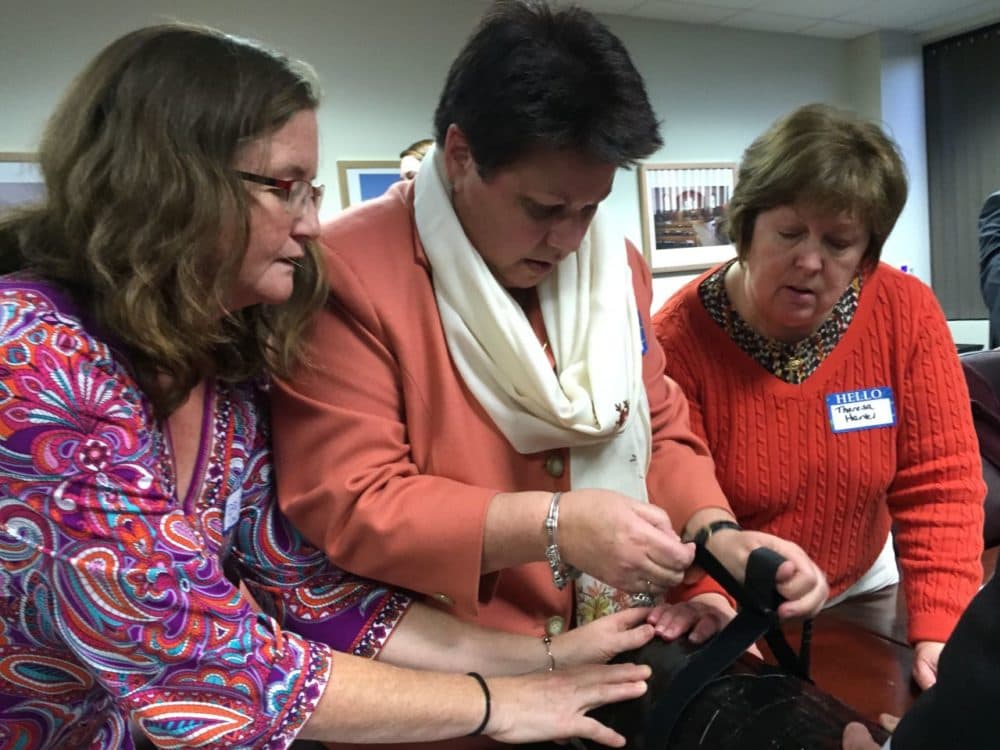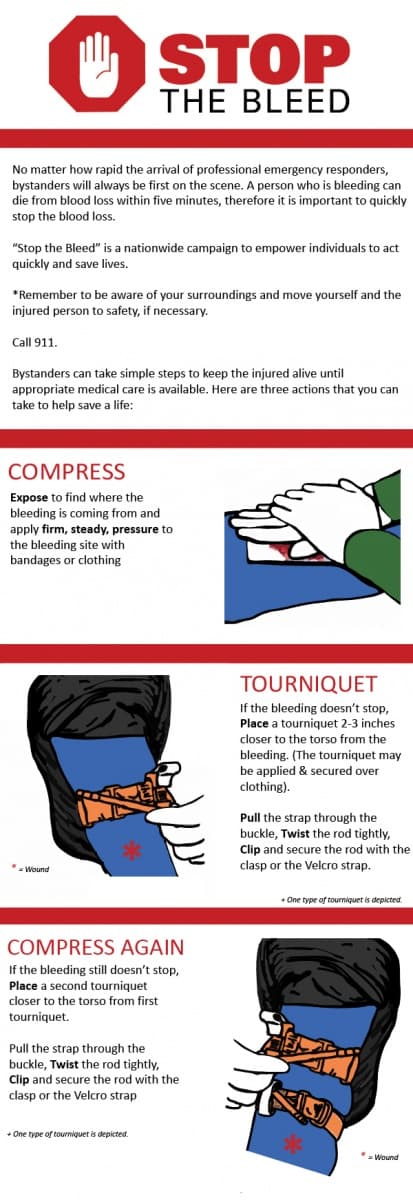Advertisement
As Mass Shootings Become More Common, A Push To Make Tourniquets Routine First Aid
Resume
CPR and the Heimlich maneuver are routine first aid. Look around schools, libraries, concert halls and many gyms and you'll see a heart defibrillator ready for action.
Now, as we face more mass shootings and other disasters, should tourniquets, used to stop severe bleeding, be just as common?
The White House says yes; it's rolling out a national campaign called "Stop the Bleed." Last week, the American Red Cross and American Heart Association updated first aid guidelines to include bleeding control and the use of tourniquets. And the Red Cross expects to add bleeding control to its online and in-person trainings in the coming months.
But one Boston surgeon isn't waiting.
'It’s The Reality In Which We Live'
"Step one, you apply direct pressure," Dr. David King tells a dozen nurses from Catholic schools in the Boston Archdiocese, gripping his right forearm to demonstrate. The nurses, all women, have gathered at the church headquarters in Braintree to learn what they can do to stop severe bleeding. King, a trauma surgeon at Massachusetts General Hospital, moves quickly to step two.
If pressure doesn't stop the flow of blood, pack the wound tight. Use specially treated blood clotting gauze if you have it, King says. If not, a T-shirt will do.
"You’ll see in 10 seconds whether that’s worked or not. If it doesn’t, what’s the next step and the final step?" King asks, looking from one face to the next. "It’s to put a tourniquet on, right?"
King grabs a handful of black plastic straps with Velcro on one side, a double buckle at one end and a small black stick the nurses would twist on the tourniquet to clamp blood vessels shut, if needed. King would like to see a tourniquet in every classroom, mall, train station — in any public place. His conviction is rooted in 14 years as an Army combat surgeon, and the 2013 Boston Marathon, which he ran. He finished before the blasts and was at MGH to meet the flood of wounded patients who came pouring in.

"After the Boston Marathon bombing, my military experience just started making me think that this is an exportable skill that we can teach anybody," King said of applying pressure, packing wounds and using tourniquets. "It’s unfortunate that we have to be teaching teachers how to do this, but it’s the reality in which we live."
Finding Extra Minutes
King is part of a national advisory group that recommends all Americans be prepared to act as immediate responders. Two weeks ago, the White House and the Department of Homeland Security embraced that idea with the “Stop the Bleed” campaign.
"Five minutes can make the difference between life and death," Deputy Homeland Security Adviser Amy Pope said at the campaign launch, about how quickly someone injured in a shooting, bomb blast, tornado or train accident can bleed to death.
"We want to make sure more people can survive a severe injury," Pope continued, "that more people will have more than five minutes, more time to be treated and seen by a professional, more time to live."
The campaign plans public education announcements and widespread access to bleeding control kits with tourniquets.
The Red Cross's decision to update its first aid update guidelines is in response to the national campaign.
“The Red Cross feels that every American needs to know how to care for someone who has massive, life threatening bleeding,” said Jonathan Epstein, senior director of science and content for the American Red Cross. “Recent incidents at schools and malls, the Boston Marathon, are all situations that have pushed health care and emergency medicine to make sure that citizens can respond in an emergency.”
Dr. King wrote his own script and is scheduling his own trainings.
Empowered To Save A Life
The Catholic school nurses gathered for the training break into small groups and practice threading and tightening a tourniquet on themselves. Then, with King watching, they test the tourniquet on a tube-shaped pillow that King has wrapped in black duct tape. It's about the size and density of someone’s thigh.
"Wait a minute, I’m stuck," says Elizabeth Paquette, the nurse at Malden Catholic High School, looking perplexed.
Threading the buckle twice for maximum tension, and then pulling the strap hard enough to close off bleeding completely, is hard. King has some tips.
"I put my hand on the leg," he says, demonstrating, "I push [the leg] away from me, while I pull the free end [of the tourniquet] towards me."
Theresa Hartel, the nurse at Boston College High School, takes a turn. She leans into the dummy thigh and then yanks back with a mighty pull.
"Oh, go Theresa," her fellow nurses yell, "that’s what we were missing."
Hartel twists the little black bar or windlass on the tourniquet to increase the tension.
"Wow, Theresa," says Bridget Jaklitsch, the nurse at St. Francis Xavier in South Weymouth.
"He’s not bleeding anymore," Paquette announces.
Jaklitsch says she is disturbed to think school nurses need this training, but she wants to be prepared.
"As nurses we are first responders, whether it be at school or a marathon. I was there the day of the Boston Marathon," Jaklitsch says. "Anytime there's an emergency, we react. To have the knowledge about how to put on a tourniquet, I’m thrilled that Dr. King was here today to teach us that."
King grins watching nurses master this new first aid skill, even if it is in response to a grim reality.
"You can talk about preventing these incidents and that’s a move for the legislature and us as voters," King says, "but that may take months or years or may never happen. I’m going to leave this teaching session today with a group of empowered nurses who now know what to do tomorrow. It doesn’t take an act of Congress. It took us 30 minutes on a Wednesday afternoon and they’re empowered to save a life now."
Empowered with a skill these women hope they'll never need to use.
This article was originally published on October 23, 2015.

